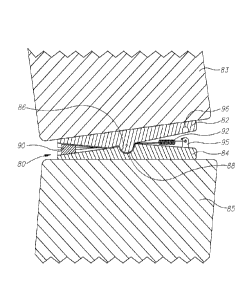Some of the information on this Web page has been provided by external sources. The Government of Canada is not responsible for the accuracy, reliability or currency of the information supplied by external sources. Users wishing to rely upon this information should consult directly with the source of the information. Content provided by external sources is not subject to official languages, privacy and accessibility requirements.
Any discrepancies in the text and image of the Claims and Abstract are due to differing posting times. Text of the Claims and Abstract are posted:
| (12) Patent: | (11) CA 2862828 |
|---|---|
| (54) English Title: | SPINAL CAGE |
| (54) French Title: | CAGE VERTEBRALE |
| Status: | Granted |
| (51) International Patent Classification (IPC): |
|
|---|---|
| (72) Inventors : |
|
| (73) Owners : |
|
| (71) Applicants : |
|
| (74) Agent: | NORTON ROSE FULBRIGHT CANADA LLP/S.E.N.C.R.L., S.R.L. |
| (74) Associate agent: | |
| (45) Issued: | 2019-03-19 |
| (86) PCT Filing Date: | 2013-01-07 |
| (87) Open to Public Inspection: | 2013-07-18 |
| Examination requested: | 2017-09-25 |
| Availability of licence: | N/A |
| (25) Language of filing: | English |
| Patent Cooperation Treaty (PCT): | Yes |
|---|---|
| (86) PCT Filing Number: | PCT/US2013/020454 |
| (87) International Publication Number: | WO2013/106263 |
| (85) National Entry: | 2014-07-02 |
| (30) Application Priority Data: | ||||||||||||
|---|---|---|---|---|---|---|---|---|---|---|---|---|
|
A spinal cage (80) including first and second spinal attachment members (82, 84) attachable to vertebrae (83, 85), the first and second spinal attachment members (82, 84) articulating with one another by means of an articulation joint (86, 88), characterised by a wedge element (90) arranged for wedging between the first and second spinal attachment members (82, 84), and an actuator (92) linked to the wedge element (90) for moving the wedge element (90) in a direction that wedges the wedge element (90) further in between the first and second spinal attachment members (82, 84) or further away from the first and second spinal attachment members (82, 84).
La présente invention concerne une cage vertébrale (80) comprenant des premier et second éléments de fixation vertébrale (82, 84) qui peuvent être reliés à des vertèbres (83, 85) et qui sont articulés les uns par rapport aux autres par le biais d'une articulation (86, 88), laquelle cage est caractérisée par un élément cale (90) conçu pour assurer le calage entre le premier et le second élément de fixation vertébrale (82, 84), ainsi qu'un actionneur (92) qui est relié à l'élément cale (90) et est conçu pour déplacer ce dernier dans une direction qui permet de caler plus loin l'élément cale (90) entre le premier et le second élément de fixation vertébrale (82, 84), ou de l'éloigner du premier et du second élément de fixation vertébrale (82, 84).
Note: Claims are shown in the official language in which they were submitted.
Note: Descriptions are shown in the official language in which they were submitted.

For a clearer understanding of the status of the application/patent presented on this page, the site Disclaimer , as well as the definitions for Patent , Administrative Status , Maintenance Fee and Payment History should be consulted.
| Title | Date |
|---|---|
| Forecasted Issue Date | 2019-03-19 |
| (86) PCT Filing Date | 2013-01-07 |
| (87) PCT Publication Date | 2013-07-18 |
| (85) National Entry | 2014-07-02 |
| Examination Requested | 2017-09-25 |
| (45) Issued | 2019-03-19 |
There is no abandonment history.
Last Payment of $263.14 was received on 2023-12-18
Upcoming maintenance fee amounts
| Description | Date | Amount |
|---|---|---|
| Next Payment if small entity fee | 2025-01-07 | $125.00 |
| Next Payment if standard fee | 2025-01-07 | $347.00 |
Note : If the full payment has not been received on or before the date indicated, a further fee may be required which may be one of the following
Patent fees are adjusted on the 1st of January every year. The amounts above are the current amounts if received by December 31 of the current year.
Please refer to the CIPO
Patent Fees
web page to see all current fee amounts.
| Fee Type | Anniversary Year | Due Date | Amount Paid | Paid Date |
|---|---|---|---|---|
| Application Fee | $400.00 | 2014-07-02 | ||
| Registration of a document - section 124 | $100.00 | 2014-10-07 | ||
| Maintenance Fee - Application - New Act | 2 | 2015-01-07 | $100.00 | 2014-12-30 |
| Maintenance Fee - Application - New Act | 3 | 2016-01-07 | $100.00 | 2015-12-23 |
| Maintenance Fee - Application - New Act | 4 | 2017-01-09 | $100.00 | 2016-12-29 |
| Request for Examination | $800.00 | 2017-09-25 | ||
| Maintenance Fee - Application - New Act | 5 | 2018-01-08 | $200.00 | 2017-11-21 |
| Maintenance Fee - Application - New Act | 6 | 2019-01-07 | $200.00 | 2018-11-28 |
| Final Fee | $300.00 | 2019-01-30 | ||
| Maintenance Fee - Patent - New Act | 7 | 2020-01-07 | $200.00 | 2020-01-06 |
| Maintenance Fee - Patent - New Act | 8 | 2021-01-07 | $200.00 | 2020-12-30 |
| Maintenance Fee - Patent - New Act | 9 | 2022-01-07 | $203.59 | 2022-01-04 |
| Maintenance Fee - Patent - New Act | 10 | 2023-01-09 | $254.49 | 2022-12-22 |
| Maintenance Fee - Patent - New Act | 11 | 2024-01-08 | $263.14 | 2023-12-18 |
Note: Records showing the ownership history in alphabetical order.
| Current Owners on Record |
|---|
| APIFIX LTD. |
| Past Owners on Record |
|---|
| None |